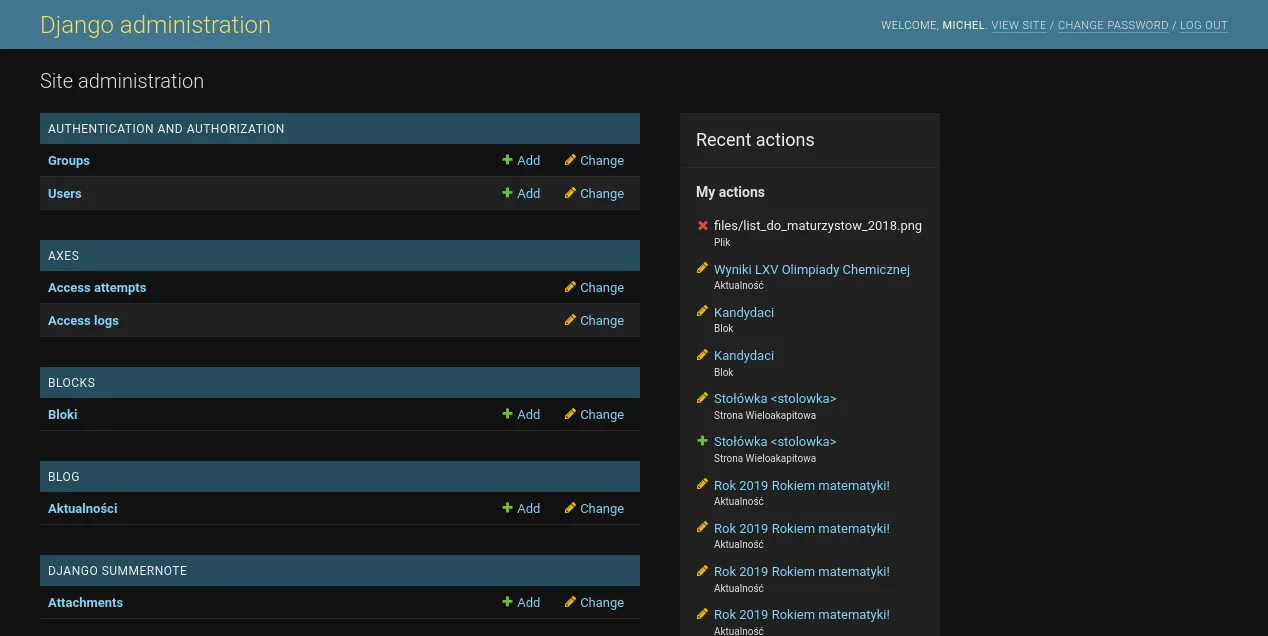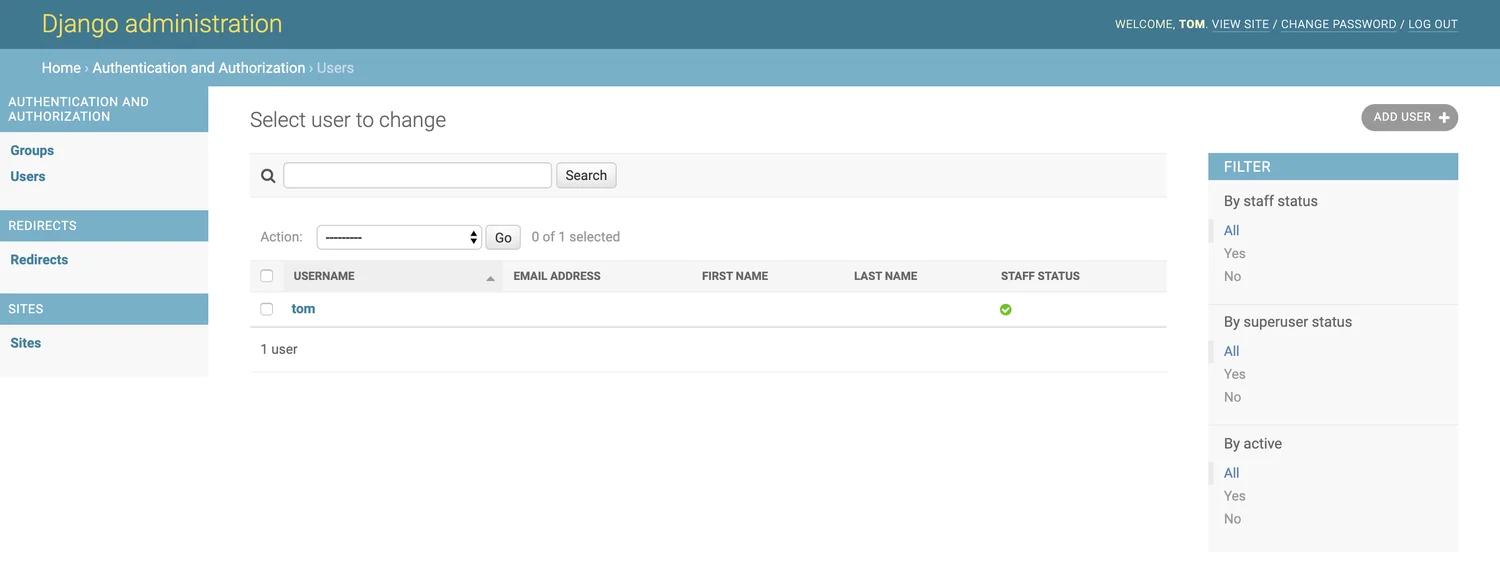It’s that time again, time for another Django LTS release. Since Django 2.2, back in 2019, a lot has changed in tech, in Python and of course in Django.
Historically, I’ve worked entirely on LTS versions, hence combining these 3 releases together. Staying on the LTS version is a trade-off between stability and shiny new features, but there’s no right answer as to which you should be on. If you’re not in the habit of upgrading often, stick with the LTS releases. If you enjoy loving life in the fast lane, moving fast and breaking stuff, then the regular releases are for you. That’s not to say they’re worse, just not supported for as long, so when security issues hit, you’re on your own.
#Shiny Newness
This is far from all the changes since 2.2, those can be found on in the release notes for 3.0, 3.1 and 3.2. These are simply the bits I found most interesting or most useful to my development life. If you’re basing your upgrade path purely off this post and not reading the full release notes for yourself, you’re in for a bad time.
#Asynchronous Server Gateway Interface
Without a doubt, the flagship feature of the Django 3.x release cycle has been ASGI support, and thus it’s now possible to write async Django.
Django 3.0 introduced an ASGI handler, allowing ASGI-compatible servers like uvicorn to be used to serve Django applications. This doesn’t mean it runs in an event loop, at least not yet, but it means Django can be run alongside other ASGI-based applications.
The best bit came in Django 3.1: Async middleware and views. Now, it’s possible to write fully async views and middleware, leveraging the full power of async. Django will happily run async views alongside sync views however, so they can be mixed and matched as needed.
import datetime
from django.http import HttpResponse
async def current_datetime(request):
now = datetime.datetime.now()
html = '<html><body>It is now %s.</body></html>' % now
return HttpResponse(html)
It’s still worth noting that not everything in Django is async-compatible, like the ORM and caching layers. Instead, these are automatically pushed to a background thread pool, so other tasks can be processed without blocking the event loop. The same principle is used to run sync views under ASGI.
Something important to remember: Async isn’t necessarily always better. In fact in some cases, it can be much worse. async works best when heavily context switching, thus plays well with IO-intensive workloads. With CPU-bound workloads, all tasks in the async pool are blocked whilst 1 is completing work, which massively affects performance.
Andrew Godwin, who headed most of the ASGI work in Django (and asgiref) gave a great talk about how the async implementation works in Django, and when not to use it.
There’s also a dedicated page in the docs about it.
#Django version support
Starting with the release of Django 3.0, the Django maintainers set out some “suggestions” for which versions of Django 3rd-party packages should support:
Following the release of Django 3.0, we suggest that third-party app authors drop support for all versions of Django prior to 2.2
I’ve seen, used and even contributed to packages which still claim support for Django 1.8, which was end-of-life back in 2018. Personally I maintain support for any actively maintained version of Django, if it works on older versions that’s a bonus. It’s nice to see some suggestions around this, though, and what people think is a “reasonable” support window.
#No more Python 3.5
Python 3.5 was quite a Python release. It was the start of Python’s async story, with the introduction of the async and await keywords. Now, many years later, it’s dropped off the end of the Python support lifecycle. Now Django too, no longer supports it. It might still work, but I definitely wouldn’t be depending on it for production applications. I also wouldn’t want to run an unsupported version of Python at all either, but that’s just me.
enum.Enum model fields
Enums are a great way of defining a set of values in a way which can be reused in a type-safe way.
class Color(enum.Enum):
RED = 1
GREEN = 2
BLUE = 3
Enums like this would be a great fit for Django’s CharField choices, as in those cases you generally want just a few specific values rather than any string. Previously the only way to do this was to do it yourself, or using something like django-model-utils’s Choices.
Finally, in Django 3.0, you can get rid of that. You can natively pass Enums as choices arguments to fields. Django will automatically cast to and from the Python-land Enum type when reading and writing to the database.
If you’re interested in how Django’s choices work, and how the changes in 3.0 make life so much easier, there’s a great talk from DjangoCon EU 2020 which goes into more detail:
#SmallAutoField
SmallAutoField does exactly what it says on the tin. It’s like AutoField, but smaller.
AutoField is most useful as a primary key, whereby it’s an auto-incrementing integer starting at 0. Whenever new rows are inserted, the counter increments 1 and uses that as the value. If your model doesn’t explicitly have a primary key, then Django automatically uses AutoField.
SmallAutoField is much like that, only instead of supporting values up to 2147483647, it only supports values up to 32767. 32767 being smaller than 2147483647, the name makes sense.
Personally I quite like the pattern of using Django’s smaller IntegerField types when needed, mostly because the database and wire representations are likely much smaller and thus more efficient. But it also makes you less likely to create too many rows, or increment a counter far higher than necessary.
#Default primary key customization
As mentioned before, Django uses AutoField by default when giving a model its primary key. For most people this is fine, as it’s highly unlikely you’ll create 2147483647 rows in a table. Unfortunately, for larger-scale applications this isn’t necessarily true.
2147483647 may look familiar to some. It’s the largest number it’s possible to store in a (signed) 32-bit integer. Django’s AutoField is backed by a 32-bit field, meaning that’s the largest primary it’s possible to store. Notice it’s stored as a signed value, even though only the positive space is used, meaning really you’ve only got 31-bits to store data in (which is exactly 2147483647).
It’s not uncommon for even medium-sized applications to fall victim to this issue. After inserting n rows into a table, your database rejects adding any more, which is an issue! This limitation is very well known (unless you’re Parler apparently), and so nowadays if you’re working on a table with is likely to see a large number of rows, or just never want to be caught by the issue, it’s better to use BigAutoField (which can hold 64-bits, or 9223372036854775807) or UUIDField (which can hold 128-bits, or 340282366920938463463374607431768211456).
The new change in Django 3.2 is that you can configure which field Django automatically attaches to models without a primary key. The default is still currently AutoField, however that will change in a future release. If you don’t have DEFAULT_AUTO_FIELD set, Django 3.2 shows a warning.
DEFAULT_AUTO_FIELD = 'django.db.models.AutoField' # 31-bit
DEFAULT_AUTO_FIELD = 'django.db.models.BigAutoField' # 64-bit
If you run out of 128-bit primary keys, you’re either doing something wrong or crazy (or both).
#Database-agnostic JSONField
Users of PostgreSQL will know Django has actually had a JSONField for years, in the django.db.contrib.postgres module. JSONField allowed storing valid JSON in the database, and transparently converting to and from Python dicts and lists. The postgres-specific nature of this allowed the ability to query based on keys inside said JSON fields inside the database, without needing to read and parse the entire blob in Python.
With Django 3.1, this is now available for all supported database backends, meaning everyone can take advantage of efficient storing JSON objects and querying off them.
The way it works is very interesting, and I highly recommend the Djangocon Europe 2020 talk from the creator on how it works:
#Admin antipatterns
Anyone who’s tried to write anything even remotely complex or custom in the admin, has had to deal with the fact that some features require setting attributes on methods:
class PersonAdmin(admin.ModelAdmin):
list_display = ('upper_case_name',)
def upper_case_name(self, obj):
return ("%s %s" % (obj.first_name, obj.last_name)).upper()
upper_case_name.short_description = 'Name'
Funnily enough, mypy doesn’t really like this, as functions don’t have a short_description attribute which can be set. Meaning either you’d have to # type: ignore the line and lose the mypy benefits. To newcomers to Django, this pattern is also weird and especially hard to discover.
Django 3.2 has a solution. There’s now an admin.display decorator, which is used to specify these extra details, rather than assigning attributes:
class PersonAdmin(admin.ModelAdmin):
list_display = ('upper_case_name',)
@admin.display(
description='Name'
)
def upper_case_name(self, obj):
return ("%s %s" % (obj.first_name, obj.last_name)).upper()
Now the code is significantly easier to read, more pythonic and perfectly type-safe. The same pattern change also exists for admin actions:
@admin.action(description='Mark selected stories as published')
def make_published(modeladmin, request, queryset):
queryset.update(status='p')
class ArticleAdmin(admin.ModelAdmin):
list_display = ['title', 'status']
ordering = ['title']
actions = [make_published]
#Dark themed admin
Finally, the Django admin has a dark theme! The theme is automatically enabled based on the user’s OS settings (CSS prefers-color-scheme), so it’ll nicely match the rest of the user’s environment.
I’ve been using darkreader for dark theming for a couple of years, but now this is native it’ll almost certainly look more polished. Similar things happened when GitHub unveiled a native dark mode.
Admin sidebar
The Django admin now has a sidebar. It appears both in list and detail views and shows a listing very similar to what’s found on the homepage: a list of project models. The sidebar makes it much easier to quickly switch between models without needing to jump back to the homepage.
#Admin no longer supports IE11
Internet explorer 11 - just saying those words brings me out in cold sweats. Internet explorer 11 support is the bane of any developer’s life.
Fortunately, Django is no longer one of them. From Django 3.1, there’s no longer official support for IE11 in the admin. It might work, but it’s no longer guaranteed. Chances are this not only makes the maintenance much easier, but now Django users can quote much higher numbers for maintaining IE11 support in applications, which will hopefully deter people from requiring support for it.
#Password hashing
Storing passwords is both very easy and very hard. Unless you know exactly what you’re doing, you shouldn’t be implementing it yourself. Fortunately, Django has some very strong defaults for password storage, with SHA256 for hashing, followed by n rounds of PBKDF2 on top, to further strengthen the hash.
Django 2.2 increased the number of PBKDF2 rounds quite a bit, and the 3.x series increase it even further:
- 2.0: 100000
- 3.0: 180000
- 3.1: 216000
- 3.2: 260000
The increases are getting larger each time, highlighting the fact that PBKDF2 is an ageing algorithm which may not be suitable on today’s modern hardware. Argon2 is the newcomer to the KDF ring, with more tunables. An argon2 hasher was introduced to Django in 1.10, but It’s still not the default as it requires an external library. I suspect some day soon this default will change.
As mentioned before, with greater PBKDF2 iterations comes slower tests, especially if they’re constantly creating users. Test performance is important, but there are some ways to speed it up, one of which may be to store passwords in plaintext during tests.
Along with rounds increases, the default salt size was increased from 71 bits to 128. Exactly why salting is important is a separate topic.
#Stronger Signer
Django uses hashing in a number of places internally. Not only when hashing passwords for the database (which uses a different implementation), but also:
- Password reset tokens
- Cookies
- Sessions
Signer
Prior to Django 3.1, the default algorithm was SHA1. SHA1 is now considered basically broken and not suitable for security purposes.
Django 3.1 changed the default algorithm to SHA256, a much stronger algorithm (no, not 256x stronger, that’s not how it works). The previous behaviour can be restored by setting DEFAULT_HASHING_ALGORITHM to "sha1", but unless you have a strong reason too, I recommend embracing the new stronger algorithm. Support for SHA1 will be removed in Django 4.0.
#Deny iframes
Iframes are a very weird and rarely useful part of HTML, but when they’re needed they’re invaluable. Iframes simply allow you to embed 1 website as a part of another, in its entirety.
There can however be some security issues around allowing your website to be embedded into another. Clickjacking is a method of ticking a user into clicking on something invisible or disguised as something else. For example, a malicious website could load in your banks website in an iframe (which thanks to cookies, you’d probably be logged in to), make it mostly invisible, but stick a regular button over the “Send all my money to this Nigerian prince” button. When you click what you think is the website’s button, you’re actually clicking the one on your bank. This is generally done by embedding a page using iframes.
The easiest way to mitigate this is by using the X-Frame-Options header, which instructs the browser not to allow your website to be shown in an iframe. “SAMEORIGIN” would allow yourbank.com to be embedded into you.yourbank.com but not nastybank.com. “DENY” prevents embedding altogether - because it’s 2021 and chances are you don’t need iframes!
Anyway, back to the topic of Django. Django 3.2 changes the default option to “DENY”, preventing your site from being embedded. The setting has existed for a while, and is easily changeable, so should you need iframing for whatever reason, it’s easy to keep.
#Referrer policy
Django 3.1 now sets the referrer policy explicitly to same-origin, when previously it was undefined. For most people, this is a good thing for security and privacy, however on some sites this can cause issues.
I’ll let someone else explain why.
#get_random_string length
Django’s get_random_string is a helper from django.utils.crypto I find myself using quite often. It’s a way of generating a fixed-length string of random characters, but from a source of randomness deemed “cryptographically secure”. It’s useful both for secret generation, or if you change the character set to numeric, for generating SMS tokens.
It’s used by Django internally quite a lot. A notable example is manage.py startproject, which uses it to generate a value for SECRET_KEY. Django doesn’t really have a way of generating a secure value for SECRET_KEY other than that, but that’s a different story.
Prior to Django 3.2, for reasons I don’t know, get_random_string defaulted to generating 50 characters, also the default size of SECRET_KEY. Now, that value is required. Really this shouldn’t affect you, but it’s a nice change to a really useful method.
#Database CreateExtension
Not all databases were created equal, and even those similar can be extended in different ways using extensions. PostgreSQL, my database engine of choice, supports a number of extensions which are enabled using subclasses of the CreateExtension operation.
In PostgreSQL, you have to be a superuser to enable extensions, and rightly so. Unfortunately, or at least hopefully, your web application’s database user isn’t a superuser on the database server. This is a problem when you try and run migrations and are presented with a permissions error instead.
The reason this happens in Django is quite interesting. Here’s the query Django will run to install an extension:
CREATE EXTENSION IF NOT EXISTS citext;
Looks perfect, and there’s even a check for not trying to install it if it already exists. But then, why does it fail?
It seems PostgreSQL checks if the user can perform the creation before checking whether the extension is already installed. The way I’ve got around this in the past is manually loading the extension as a superuser, then fake the migration which adds the extension.
Now, Django 3.2 explicitly checks whether the extension is installed before issuing the above query, and so assuming a superuser loads the extension, the migration will run fine. It’s kind of a pointless migration, but does assert that the extension is loaded, which is still useful.
#Queryset.alias
Whenever you’re doing a query in Django, and need to reference the value of a related model, you can annotate it onto the queryset. When doing this, Django sets it as an attribute on the underlying model, so it can be accessed in future. However, for the sake of clean reusable code, it’s often necessary to annotate a value which is used only in future filters. In this case, the value would still be returned to the client, resulting both in unnecessary computation and network IO.
Django 3.2 adds a new API: QuerySet.alias. This allows for annotating values onto the queryset, but doesn’t return them.
Blog.objects.alias(entries_count=Count('entry')).filter(entries_count__gt=5)
In this example, blog.entries_count would raise an AttribueError, because it doesn’t exist. Aliased values can be used with annotate, exclude, filter, order_by, and update. For anything else, notably aggregate, you’ll need to use annotate.
#Database functions
Back in the Django 2.2 release, there were a huge number of database functions added, especially around maths. 3.2 isn’t quite at the same level, but it still brings some interesting ones, and some interesting changes.
#Random database function
It’s now possible to generate random numbers right from the database. Random can be annotated onto a queryset, and returns a value between 0 and 1. Rather importantly, this random number is not suitable for cryptographic or security-related applications!
#Database hashing functions
As of Django 3.0, Django has the ability to hash data in the database:
- SHA1
- SHA224
- SHA256
- SHA384
- SHA512
Depending on your needs, these may be much faster than loading all the data and doing the hashing in Python.
#JSONObject
Have you ever wanted to serialize your row to JSON from inside the database? No? Well now you can anyway! The JSONObject function allows you to build up a JSON blob and annotate it onto a queryset or use it in an aggregation.
>>> from django.db.models import F
>>> from django.db.models.functions import JSONObject, Lower
>>> Author.objects.create(name='Margaret Smith', alias='msmith', age=25)
>>> author = Author.objects.annotate(json_object=JSONObject(
... name=Lower('name'),
... alias='alias',
... age=F('age') * 2,
... )).get()
>>> author.json_object
{'name': 'margaret smith', 'alias': 'msmith', 'age': 50}
Personally, I can’t quite see many use cases for this, but it’d be mighty interesting to see one. I can’t quite see it replacing DRF’s serializers any time soon, though.
#AVG and SUM database methods support distinct
To annotate the number of nested items (related using a JOIN), Django has the Count database method. Depending on the query and the filtering being done on this nested data, it’s possible for some rows to be counted twice, or more. To combat this, you can pass distinct=True, and Django will add a DISTINCT constraint ensuring rows are counted exactly once.
This functionality now also exists for the Sum and Avg functions, useful when rather than simply counting rows, you need to pull out specific values from them.
#Signed JSON
Django’s Signer is a great tool when transferring data to a user. By signing it you can prove (at least beyond reasonable doubt) that it wasn’t tampered with, intentionally or otherwise. Outside the Django world, itsdangereous is a great library to do similar things.
>>> signer.sign('hello')
'hello:1NMg5H:oPVuCqlJWmChm1rA2lyTUtelC-c'
Previously, Django would only sign primitive data types like ints and strings. In 3.2 there’s a new sign_object API, which serializes data to JSON before signing, allowing more complex data to be signed. This does still only support types which can be converted to JSON, but that’s far more secure than using Pickle (although you can swap it out to something other than JSON if you wanted to (please, not Pickle)).
Yes it’s been entirely possible to JSON format or pickle an object before signing for a while, but native functionality leads to cleaner code. And the less code I have to write, the better.
#Testing improvements
Testing is a core part of any application, no matter the size. Without testing, you can’t really be sure any piece of code works, nor that changes to it won’t break it entirely. Django has always had some great testing tools available, but 3.2 really brings some great improvements to this:
setUpTestData is a new method on Django’s TestCase class which allows you to create model instances once per test class rather than once per test case. This will massively speed up testing time, as there’s no need to keep destroying and creating test models between cases. If you can’t upgrade yet, but absolutely need this now, it can be installed separately.
Naturally, tests will fail at some point, but it’s important to understand why they fail. Generally it’ll either be because your change is wrong, so you need to fix it, or it’ll be because the test is now defunct. It’s also entirely possible that your code is right, but the test is wrong, but let’s pretend that never happens. In the event you do need to do some deep debugging into why a test case is failing, manage.py test has a handy --pdb flag, which launches you into a pdb (or ipdb, if installed) session when a test fails.
In production, when an exception is raised during a request, Django nicely catches that and returns a somewhat-friendly 500 error to the client. During tests however, that handling doesn’t happen, instead failing the test with the exception directly. In some cases, this may not be what you want, so now the test client has a raise_request_exception attribute which when set, safely responds with a 500 instead.
There are a couple more handy ones, but @AdamChainz has a great write-up on these new features.
#Non-pytz time zones
If someone ever tells you “timezones are easy”, they’re either wrong, or they’ve never really done time zones. Time zones are hard, really hard.
pytz, the library Django uses for time zones internally, can make working with time zones even more difficult if you don’t know what you’re doing (often being described as a footgun). Django 3.2 attempts to rectify this somewhat and make it easier to work with Django’s time zone internals, by supporting non-pytz time zones, like the new zoneinfo module.
Setting headers easier
The web is powered by a lot of things, one of them is headers. Changing the headers on a response lets you control the format, caching, security and performance of your site.
Django’s header APIs have been a little strange. Prior to 2.1, request headers were read from .META, which contained upper-case versions of the headers, often prefixed with HTTP_. That’s a syntax which may be familiar to PHP devs, but us python devs want an API which is a bit nicer. Setting headers on responses was nicer, but relied on pretending the response was a dict, and setting headers directly on that.
>>> response = HttpResponse()
>>> response['Age'] = 120
>>> del response['Age']
In 2.1 the headers could be retrieved from .headers, which is a simple dict. In Django 3.2, responses got the same new treatment. Response headers can be set using .headers in a nice normal way.
>>> response = HttpResponse()
>>> response.headers['Age'] = 120
>>> del response.headers['Age']
#Listing migrations
Django’s aptly-named showmigrations command lists out the migrations in a project, showing whether they’ve been run or not. Combining this with --plan in 2.2 shows you just those which need applying. However, occasionally it’s useful to see when the migration was run.
Django keeps track of the applied migrations in the django_migrations table (again, apt name). The table notes the Django app, migration name, and when it was applied.
id | app | name | applied
----+--------------+--------------+-------------------------------
1 | contenttypes | 0001_initial | 2021-03-23 11:28:41.238803+00
2 | auth | 0001_initial | 2021-03-23 11:28:41.275085+00
3 | users | 0001_initial | 2021-03-23 11:28:41.422706+00
...
Django’s always had this data, and it’s been reasonably simple to get it (SELECT * FROM django_migrations;), but there’s now a better way. In Django 3.0, showmigrations can now show the applied column, and thus when the migration was applied, without resorting to raw SQL.
#Check for unapplied migrations
Database migrations are one of the pieces which makes deployments hard. For anything high-scale, migrations and the codebase need to be both forwards and backwards compatible. For the few cases where that’s not possible, it can be critical to know whether a migration has been run before executing certain bits of functionality.
Now, it’s possible to check whether there are unapplied migrations, and do something if not. manage.py migrate --check will exit unsuccessfully when migrations aren’t up-to-date. This was achievable using a mixture of showmigrations and grep, but the less weird bash I have to write, the better. It’s possible to do similar with makemigrations --check, to see whether there are any model changes not reflected in migrations.
#Installation
Django 3.2 has now been released upon the world, which means it’s time to start upgrading projects. Django 3.2 has very little backwards incompatible, so it should be a seamless process. Django’s lifecycle puts 2.2’s end-of-life date around April 2022, which isn’t that far away.
Django 4.0’s release is set for the end of this year, and the next LTS April 2023.





